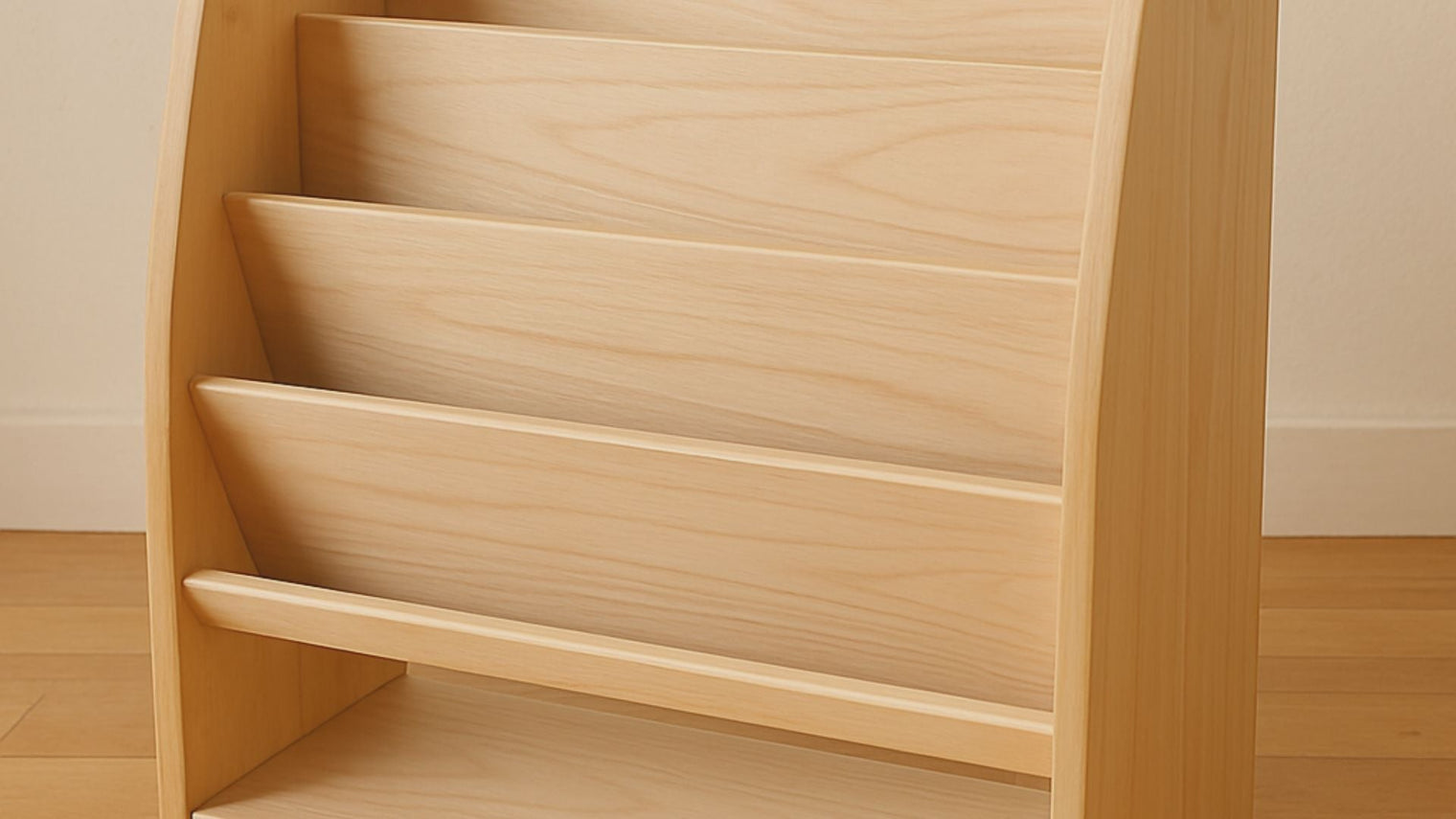Creating an environment that nurtures independence, creativity, and curiosity is at the heart of the Montessori philosophy.
One of the most effective ways to bring this philosophy into your home is through a Montessori bookshelf.
More than just a piece of furniture, it serves as an invitation for children to explore books on their own, make choices, and develop a lifelong love of learning.
But here’s the key: a Montessori bookshelf is not just about storage. How you assemble it, style it, and maintain it can greatly impact how engaged your child feels.
Done thoughtfully, it can transform reading into a daily habit and encourage your child to interact with books with joy and confidence.
At Dannico Woodworks, we understand that parents want furniture that blends durability, beauty, and child-centered design.
That’s why our Montessori bookshelves are carefully crafted to support both function and style, making it easier for parents to set up an inviting reading corner.
In this post, we’ll walk you through how to assemble and style a Montessori bookshelf for maximum learning and engagement.
Benefits of a Montessori Bookshelf
- Accessibility: Children can easily reach and return items, promoting responsibility and organization skills.
- Encourages Reading: By displaying books with their covers facing outwards, children are more likely to engage with the materials.
- Aesthetic Appeal: The simple, elegant design complements any interior while ensuring safety and functionality.
DIY Montessori Bookshelf: Materials and Tools
Creating a Montessori bookshelf is a rewarding project that combines craftsmanship with child development principles. Here’s what you’ll need:
Materials
- Wood: Opt for sturdy, non-toxic wood such as birch or pine.
- Wood Glue: For securing joints.
- Wood Screws: To ensure structural integrity.
- Finish: Choose a child-safe, non-toxic finish to protect the wood.
Tools
- Saw: For cutting the wood to size.
- Drill: For making precise holes.
- Screwdriver: To assemble the bookshelf.
- Sandpaper: For smoothing edges and surfaces.
 Step-by-Step Assembly Guide
Step-by-Step Assembly Guide
Step 1: Cut the Wood
Begin by cutting the wood to the desired dimensions. A standard Montessori bookshelf typically measures around 36 inches in length, 30 inches in height, and 12 inches in depth. However, you can customize the size to fit your space and needs.
Step 2: Assemble the Frame
Using the wood screws and wood glue, assemble the sides, top, and bottom panels to create the basic frame of the bookshelf. Ensure all joints are secure and even, as this will provide the foundation for the shelves.
Step 3: Install the Shelves
Attach the shelves at equal intervals within the frame. The number of shelves will depend on the height of your bookshelf. Ensure that each shelf is level and securely fastened.
Step 4: Sand and Finish
Smooth all surfaces and edges with sandpaper to prevent any splinters. Apply a non-toxic finish to protect the wood and enhance its natural beauty.
Styling Your Montessori Bookshelf
Once assembled, the way you style your Montessori bookshelf can significantly impact its effectiveness in fostering learning and engagement.
Organize by Theme
Arrange books and toys by theme or subject. This organization method encourages children to explore specific interests and makes it easier for them to find what they are looking for.
Rotate Materials
Regularly rotate the items on the bookshelf to maintain the child's interest. Introducing new books and toys keeps the learning environment dynamic and stimulating.
Include a Variety of Materials
Incorporate a mix of books, toys, and educational materials. This variety supports different aspects of development, from literacy to fine motor skills.
Keep It Clutter-Free
Avoid overcrowding the shelves. A clutter-free bookshelf is more inviting and allows children to focus on the materials available without feeling overwhelmed.
Ensuring Safety and Durability
Safety is paramount when designing furniture for children. Here are some tips to ensure your Montessori bookshelf is both safe and durable:
- Secure to the Wall: To prevent tipping, secure the bookshelf to the wall using brackets or straps.
- Smooth Edges: Ensure all edges are rounded and smooth to prevent injuries.
- Regular Maintenance: Check for loose screws or any signs of wear and address them promptly.
FAQs
Why is a Montessori bookshelf better than a traditional one?
Traditional bookshelves often display spines, which can be hard for young children to recognize. Montessori shelves show the covers, making it easier for kids to make choices independently.
How many books should I display at once?
Keep it between 8–12 books. Too many options can overwhelm children and reduce engagement.
What age is appropriate for a Montessori bookshelf?
From as early as 6 months (for board books) up to elementary school age. The design supports independence at any stage of early childhood.
Should I only use Montessori-approved books?
Not at all. While Montessori-friendly books (realistic images, nature themes, diversity) are great, the goal is to nurture your child’s curiosity. Choose books that reflect their interests.
How often should I rotate books?
Every 2–4 weeks is ideal, but follow your child’s cues. If they’re still fascinated with a certain book, leave it longer.
Why a Montessori Bookshelf Is Worth It
A Montessori bookshelf is more than just furniture—it’s an investment in your child’s growth.
When styled thoughtfully, it promotes independence, nurtures curiosity, and creates a lifelong love for reading.
At Dannico Woodworks, we build bookshelves with these goals in mind. Each piece is crafted to be safe, durable, and beautifully designed to fit into your home while giving your child the tools to thrive.
If you’re ready to create a reading space that sparks joy and learning, explore our handcrafted Montessori furniture.
Final Thought
Your child’s relationship with books can shape how they learn, imagine, and connect with the world.
With a thoughtfully styled Montessori bookshelf, you’re not just organizing books—you’re creating an environment that empowers independence and curiosity.
What books will you choose to display first on your child’s shelf?


